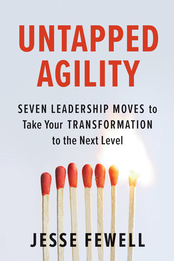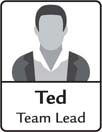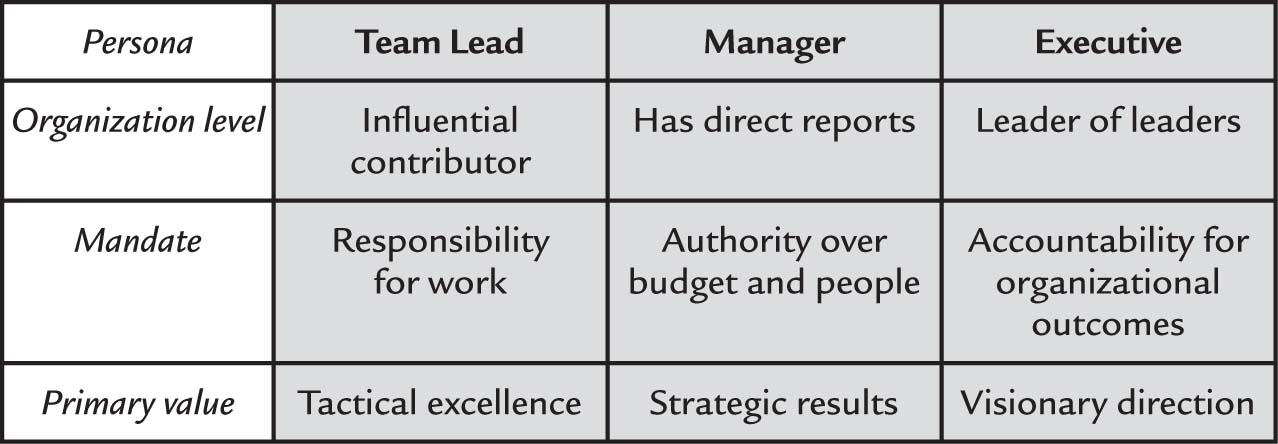
Download PDF Excerpt
Rights Information
Untapped Agility
Seven Leadership Moves to Take Your Transformation to the Next Level
Jesse Fewell (Author) | Joe Bronzi (Narrated by)
Publication date: 07/21/2020
Agile transformations are supposed to make organizations modern, competitive, and relevant. But in the well-intentioned effort to move into the future, change leaders find themselves frustrated by pushback, limited impact, poor practices, and unfair criticism. What's going on?
Jesse Fewell's book cuts through the “quick-fix” hype of agile theory and explains a recurring transformational pattern that unpacks what holds organizations back. The boost is the initial gains from logical first steps; the barrier is the unavoidable roadblock that must come next; and the rebound is the way forward to further gains by leaning against the concept of the original boost. With these counterintuitive rebounds, Fewell identifies seven leadership moves that can be used to unblock stalled agile transformations.
No, your transformation is not a failure. It turns out the buy-in, the talent, the alignment, and the growth you need to break through are already in front of you; it's all simply hidden under the surface—undiscovered, unutilized, and untapped.
Find out more about our Bulk Buyer Program
- 10-49: 20% discount
- 50-99: 35% discount
- 100-999: 38% discount
- 1000-1999: 40% discount
- 2000+ Contact Leslie Davis ( [email protected] )
Agile transformations are supposed to make organizations modern, competitive, and relevant. But in the well-intentioned effort to move into the future, change leaders find themselves frustrated by pushback, limited impact, poor practices, and unfair criticism. What's going on?
Jesse Fewell's book cuts through the “quick-fix” hype of agile theory and explains a recurring transformational pattern that unpacks what holds organizations back. The boost is the initial gains from logical first steps; the barrier is the unavoidable roadblock that must come next; and the rebound is the way forward to further gains by leaning against the concept of the original boost. With these counterintuitive rebounds, Fewell identifies seven leadership moves that can be used to unblock stalled agile transformations.
No, your transformation is not a failure. It turns out the buy-in, the talent, the alignment, and the growth you need to break through are already in front of you; it's all simply hidden under the surface—undiscovered, unutilized, and untapped.
CHAPTER 1
Transformation Frustration
Expectations were like fine pottery. The harder you held them, the more likely they were to crack.
—Brandon Sanderson, The Way of Kings
This book is about leading change, and we need to start with a story. I once worked for a startup entrepreneur named Jeff who told me a business story so compelling, I will never forget it.
Jeff was a colorful character, whose first career was that of a restaurateur. Jeff was a force of nature and over the years worked his way up from busboy to server to sommelier to general manager to restaurant builder. One year, he was sent off to a hot new location to build the latest Planet Hollywood, the franchise eateries famous for their décor patterned after the movies. Their playbook was solid, with key criteria for geography, layout, furniture, décor. These guys knew how to build a repeatable premier experience. The boss told him, “Your new location build-out is a slam dunk. The space is in a great location, and we got the old building at a steal. Just renovate and launch, and this place will make money.”
With his orders in hand, Jeff traveled to the property to meet the contractors who would construct the new location. When he arrived, he saw firsthand the easy access from the main roads and the busy retail foot traffic. Everything looked promising. Until he went inside.
There, standing in the middle of his promising new restaurant space, was a giant, ugly column. It was a massive monstrosity; it took several people holding hands to surround it.
Jeff summoned his new team and said, “Hi there. Nice to meet you all. I’m hoping someone can tell me, what is that?” “Well, boss, that is a load-bearing column. We can’t demolish it, so we’ll have to build around it.” Frustration welling up inside him, Jeff said, “That thing consumes dining space and is a giant eyesore. What do we do?” Immediately the team started brainstorming:
Could they use it as a bar? Nope, too centrally located inside the dining space.
Could they use it as the guest reception desk? Nope, it was too big to do that elegantly.
Could they move the point-of-sale systems there? Nope, too far from some of the dining sections.
The team was stumped. In all his years of expertise, Jeff had never come across anything like this. Eventually they realized the column could serve no functional purpose. It was just there. Jeff asked the team, “What if we just let it be? We could at least make it appealing and hang décor items on it.” “Maybe,” said one of the contractors. “But the prop mounts are designed for flat walls, not curved surfaces.” Another chimed in, “Instead of hammers, we could use paint. How about a custom mural depicting various movie scenes?” The group got a little more animated, and another person wondered, “What if that mural rotated slowly around that column, so that customers got to see different parts of it as they dined?”
There were no silver bullets, but with some ideas in hand, they began working. After a few months of feverish scrambling, the restaurant was set to open on schedule. Meanwhile, Jeff was still nervous. Yes, the team put in their best creative efforts, but this was still very different from the standard blueprints, the standard designs, the standard brand layout. There was a ton at stake, and it just felt wrong.
Except customers loved it.
“This is so cool,” they said. “We’ve never seen anything like this,” they said. “We’ve been to Planet Hollywood locations around the world and this is our new favorite,” they said. Despite the roller-coaster ride, it became Jeff’s most successful project to date.
That is what untapped agility is all about.
We boost forward with a solid plan. Eventually we hit a frustrating barrier. Finally, we take the risk of rebounding on an alternate path forward.
In the world of work, fewer endeavors draw more hype and yield more frustration than the lofty goal of “business transformation.” Companies around the world are facing new and unexpected challenges. More disruption, more change, more competition than ever before. For most of us, the strategic response is to reboot the organization to achieve a greater degree of agility. That almost always takes the shape of a formal change initiative to embrace one or more of those latest management buzzwords like Design Thinking, DevOps, Lean Startup, Holacracy, Scrum, or Kanban.
Unfortunately, every single one of those transformations go through the same roller-coaster ride that Jeff went through. This book is about how to ride that roller coaster without losing your mind in the process.
The Pattern of Untapped Agility
I have examined dozens of case studies and interviewed several transformation leaders to find out how they achieve the results that everyone else is finding so hard to achieve. In my research I found a surprising pattern. Over and over, leaders walked through a familiar sequence:
1. The Boost. Most leaders start with a proven first step to generate momentum. They begin with “the right things.” Planet Hollywood’s playbook had worked before and even generated a win—the great location for the Jeff’s restaurant. Moreover, Jeff and his team had good reason to turn to standard solutions: he was super successful at solving problems with that expertise. Similarly, when launching an effort to create the modern organization, conventional wisdom is a good place to start. Leaders are justified when starting with proven steps like taking initiative, mobilizing their teams, and installing best practices.
2. The Barrier. However, after that initial momentum, leaders encounter common human barriers. Jeff and his team struggled with the column problem because they were relying on what had worked before: practical, functional, “tidy” solutions. That column didn’t play fair, and neither does change. The reason for transformation headaches is that organizations are a complex mesh of people, and the people business is a sticky business. It’s not a matter of good or bad, it’s a matter of reality. Once we accept the barrier, we can move forward.
3. The Rebound. The way forward is a different direction. Instead of merely brute-forcing the initial strategy through the barrier, leaders yield further gains by leaning against the concept of the original boost. Jeff’s original successes were based on following established career patterns and a proven construction playbook. But that load-bearing column would not permit progress using any known established practice. The way forward needed to break the mold. So the team leaned into the awkwardness and tried a strategy that was decidedly not following the playbook. Many change champions will either push harder in the face of barriers or simply give up and blame everyone else. Others are able to step sideways toward breakthrough results, by using specific leadership moves.
The Untapped Agility Pattern

No, your transformation is not a failure. It turns out the buy-in, the talent, the alignment, and the growth you need to break through are already in front of you; it’s all simply hidden under the surface. Undiscovered. Unutilized. Untapped.
Let’s take a look at how this pattern plays out on an industrial scale.
Transformations Boost Results
The good news is, these modern ways of working actually do work. Over and over again, we see data and case studies that paint a compelling picture of achieving greater outcomes through specific change initiatives. Let’s take a look at the most popular modern transformation movements.
Lean Startup Has Executive Attention
The Lean Startup technique began as a way to help small ventures get aligned with their customers as quickly as possible, before running out of cash. Popularized by Eric Ries and Steve Blank, the fundamental idea is to avoid wasting time and money on the wrong business idea. Senior leaders from Alaska Airlines to 3M saw real opportunity for applying this entrepreneurial framework to larger companies.
According to research published in the Harvard Business Review,1 a meaningful percentage of corporate executives have seen the technique enable decisions based on evidence rather than instincts (67 percent), faster development of ideas (61 percent), better customer feedback (55 percent), speaking directly to customers (54 percent), and more flexibility adapting ideas through the life cycle (48 percent). Moreover, in his book The Startup Way,2 Ries tells a provocative story of how the adoption of Lean Startup at General Electric accelerated good products and killed bad ones.
Agile Benefits Are Practically Guaranteed
In 2001, a small group of technology thought leaders issued an online charter known as the Manifesto for Agile Software Development.3 It was a bold, simple statement that prioritizes customer satisfaction, frequent delivery, and empowered teamwork. In the years since, what started as a modest technology movement has exploded into a management revolution. By defining a set of core values and principles, those early advocates inspired a whole host of techniques and methodologies. But are those values, principles, and techniques actually helpful or merely hype?
Every year, the community asks themselves that very question. The most recent State of Agile Report shows a shocking result.4 For eleven key outcomes, teams are literally more likely to get a given benefit than they are to even want it. For example:
• 43 percent want agile for more quality, but 47 percent got it.
• 51 percent wanted more productivity, but a full 61 percent got it.
• 62 percent were motivated by more adaptability, yet 69 percent achieved it.
For eleven key outcomes, teams are literally more likely to get a given benefit than they are to even want it.
Put another way, if you set out to improve your adaptability, productivity, customer alignment, predictability, quality, visibility, morale, risk, engineering discipline, or remote collaboration, then it is a statistical slam dunk you’ll get those things. Meanwhile, the Agile Alliance has amassed a database of nearly 200 experience reports describing in more detail how agile methods have improved work around the world.5 Indeed, a Google search for “agile case studies” yields over 34 million hits.
Suffice it to say, agile works. There’s evidence to support it. And people know it.
DevOps Is a Big Boost to the Bottom Line
As popular as agile became in the tech industry, one group in particular felt left out: operations and infrastructure. In 2009, a number of those professionals convened their own mini-conference, discussing how to automate traditionally manual operations tasks, how to build technology that was “operations-proof,” and how to bridge the organizational silos between those who build software and those who support it. Those concepts were posted on social media, tagged with #DevOps, and promptly went viral.6 It sparked a new conversation about expanding agility to include both R&D and operations. A decade later, DevOps has evolved into its own movement with a vibrant $3.5 billion market.7
And there’s good reason. In a seminal 2014 research white paper,8 we see two compelling discoveries:
• “Strong IT performance is a competitive advantage. Firms with high-performing IT organizations were twice as likely to exceed their profitability, market share and productivity goals.”
• “DevOps practices improve IT performance. IT performance strongly correlates with well-known DevOps practices such as use of version control and continuous delivery. The longer an organization has implemented— and continues to improve upon—DevOps practices, the better it performs. And better IT performance correlates to higher performance for the entire organization.”
So, DevOps is much more than a mechanical upgrade of the technology infrastructure used by those Ops people. It correlates to the kind of organizational performance that doubles your chances of business success.
Lean Startup, Agile, and DevOps are just three of the several methods associated with agility, but already you can see the case is closed. These transformations work. Over time, doing things differently yields better results. We’re done, right? We won, didn’t we?
And Yet, Everyone Is Frustrated
Despite all those benefits, the picture is not all rainbows and unicorns. On the one hand, we have thousands of organizations declaring victory with transforming business using these modern movements. On the other hand, a lot of people are very, very frustrated.
Our Staff Are Disgruntled
Change is hard. Just ask the people trying to make it happen. In a 2017 change management study,9 60 percent of those championing agile ways of working experienced “moderately to very severe resistance.” Consider for a moment: that means staff resist concepts intended to empower them, managers resist changes proven to improve productivity and predictability, and executives resist transformations shown to boost the bottom line. That is more than ironic, it’s deeply discouraging.
Even more concerning, those leaders who are declaring transformational victory are not supported by their staff. The 2018 State of DevOps reports a serious perception gap around the maturity of modern organizational capabilities.10 Specifically, an average 58 percent of executives believe they’ve achieved a given practice, while only 37 percent of the teams on the ground see it that way. This means a significant number of those working on the ground have the unhappy situation of hearing their boss say, “Oh, we’re agile now,” when from their perspective, it’s just not true.
Thought Leaders See Their Vision Perverted
Meanwhile, some of the very people who started these movements are rather perturbed. The more popular agility becomes, the more large corporations want to jump on board. Eventually we start to see some common Dilbert-esque patterns showing up: proprietary methodologies, expensive tools and templates, glitzy conferences, and bloated certifications.
In a viral, blistering blog post,11 one of the creators of that original Agile Manifesto, Dave Thomas, declared the whole thing to be dead, saying, “The word ‘agile’ has been subverted to the point where it is effectively meaningless, and what passes for an agile community seems to be largely an arena for consultants and vendors to hawk services and products.”
“The word ‘agile’ has been subverted to the point where it is effectively meaningless, and what passes for an agile community seems to be largely an arena for consultants and vendors to hawk services and products.”—Dave Thomas
Indeed, pioneer of the Lean Startup movement Steve Blank recently pondered his own impending irrelevance.12 His movement was born of the great recession, when startup capital was scarce. Now, with so many startup companies going IPO, institutional investors are throwing much more money at ventures than ever before. Naturally, this invites some executives to scoff at the notion of empirically measuring and iterating on small bets. “How quaint. That’s, like, so five years ago.”
Granted, Blank is willing to let bazillionaires blow their funds prematurely, but he and others are growing annoyed that other mainstream organizations are whittling away the discipline and rigor they were initially able to inspire.13
As these pioneers see it, traditional business practices are more successful at diluting agility, rather than the original vision of agility transforming business practices. Although always a concern since day one, this sentiment has only been getting louder in recent years.14
The true believers feel betrayed.
Executives Are Still Deeply Worried
Today, General Electric is not what we thought it should be. In less than a year after Ries published their Lean Startup case study, GE suffered several layoffs, divested some of its oldest business units, and was removed from the Dow Jones industrial average. Of course, public struggles invite critics, who argue that the Lean Startup method was at best ineffective and at worst instrumental in those struggles. The agile community quickly shot back. Ries’s colleague Steve Blank drafted a strong rebuttal defending the method, saying, “No innovation program, lean or otherwise, would have helped the dismal performance of its power segment.”15 That is poor consolation to executives who are now faced with a dilemma: either agile methods don’t work at all, or they simply won’t work well enough to save their dying organization.
They’re not the only ones. I was personally involved at an agile transformation at Xerox in 2018, and despite the well-intentioned efforts of very intelligent people, layoffs continued as part of an ongoing restructuring of the company. For some organizations, these transformations may well be too little too late. As a result, senior leaders are worried whether these techniques will work for them. A recent study involving over 1,000 organizational executives found only 47 percent believe they can extract sustainable value from agile transformations.16 Indeed, only half (51 percent) believe they can generate even short-term wins, let alone the long-term impact.
Despite the success some leaders are seeing, there is still a crisis of transformation confidence among many C-suites.
The Barriers
On the one hand, we see almost guaranteed benefits, improved bottom lines, and a corpus of successful case studies. On the other hand, we see a broad set of leaders, practitioners, and innovators declaring “agile has failed our expectations.” It begs the question: why? Why on earth is my transformation not performing? Why am I not seeing the results I hoped for? Why is my boss so agitated? Why have we been let down by agile, Design Thinking, Lean Startup, DevOps, and all the other variations of modern management?
These questions have been asked many times. I’ve collected and compared several industry surveys from 2017 to 2019 that describe the state of modern practices around the world. If you add it up, it’s nearly 6,500 people across industries, across all kinds of sectors, all telling the same story as to what barriers are impeding the full potential of their transformation.17
Here’s what people are consistently saying is holding us back:
• Culture and structure (nine mentions in four surveys). Whether it’s “minimal collaboration and knowledge sharing” or “shifting from a command-and-control culture” or “lack of trust” universally, leaders and staff alike have observed the organization itself is its biggest barrier to change.
• Insufficient resources (six mentions in five surveys). From “insufficient training and education” to lacking the “necessary people or funding,” people feel critical elements to success are missing.
• Inconsistent and complex processes (seven mentions in three surveys). Another key obstacle to improvement is just how complicated companies are internally. Staffs feel overwhelmed by “lack of standardized mechanisms,” a “jumble of legacy processes,” and even inconsistent terminology.
• General resistance to change (four mentions in three surveys). Meanwhile, there’s inertia. Given the “pervasiveness of traditional development methods” and the general difficulty of “behavior change,” it makes sense that you’ll often hear, “But this is how we’ve always done things.”
• Existing roles and responsibilities (five mentions in two surveys). People like knowing where they stand. You may not be surprised to hear these transformations have project managers and project management offices feeling very much in limbo. But senior leaders also worry that these empirical, customer-driven approaches “threaten executives’ decision-making authority.”
• Business context (six mentions in three surveys). No two organizations are the same. Therefore, the unique dynamics of your business can seem fundamentally incompatible with faster delivery, collaboration, or transparency. It could be really hard to handle “regulatory compliance,” or “increased [product] complexity,” or “to create a [prototype] in our industry.”
• Inadequate leadership support (four mentions in four surveys). We hear over and over again the need to “get leadership buy-in” for working a better way. Despite the fact that most transformations are launched by executives, staff still does not feel supported.
Wow. There it is. These are the reasons we aren’t as agile/lean/digital/innovative as we expected we would be by now. Now that we got that off our chests, it’s time for a reality check. These are all legitimate concerns, but I have a rude awakening for everyone: these challenges will never go away. The barriers will always be there. Therefore, we have to learn how to deal with them.
These challenges will never go away. The barriers will always be there. Therefore, we have to learn how to deal with them.
The Rebound
The Planet Hollywood playbook kickstarted Jeff’s project. But that playbook only got him so far. He didn’t do anything wrong, he simply took his boost to the inevitable crossroads. That barrier forced him to explore doing something that was decidedly not in the playbook.
Marcus Aurelius wrote: “Our actions may be impeded, but there can be no impeding our intentions or dispositions. Because we can accommodate and adapt. The mind adapts and converts to its own purposes the obstacle to our acting. The impediment to action advances action. What stands in the way becomes the way.” Just like the giant column in Jeff’s restaurant, the thing that hinders us the most is the very thing we need to address. Put another way, the obstacle he faced and the ones we just listed quite literally are the job of transformation.
The Seven Leadership Moves

Stop selling, start aligning
• Generate buy-in with the big picture and personal desire

Give it away
• Enlist other champions despite the changes they make

Throw the textbook away
• Find your way by breaking free from textbook techniques

Master “no”
• Achieve focus by ruthlessly deferring projects and improvements

Attack culture and structure together
• Shepherd the intangible through tangible experiments

Look in the mirror
• Enable their transformation by mastering your own

Own the narrative
• Build confidence and credibility by reframing failure as progress
I know, I know—that may be a great sound bite, but it’s not a solution. What do we do?
In this book, I detail seven leadership moves to rebound into untapped agility. The rebound is about (1) understanding the side effects of our initial strategy, and then (2) moving with intent toward the seemingly opposite approach. It’s important to note that the rebound is not about undoing the momentum generated. Rather, it’s about leveraging the other side of the proverbial coin, the yin to the yang.
The figure shows those seven leadership moves. This is just a teaser. We will dedicate a chapter to each one.
Three Leadership Personas
To help us understand how these patterns and moves apply to all leaders of all walks, we will be using three personas. Ted, Maria, and Emmit encapsulate the varying expectations and struggles experienced by leaders at different levels in the organization. These three personas will help humanize the issues at hand. We’ll be able to see the transformation journey through their eyes, and thus make sense of it on a personal level.
These are overgeneralizations, as all personas are. The sample titles are not exclusive to any persona. You will likely see aspects of your actual role represented in each. In truth, that reflects the complexity of the challenges we face.
Defining Agility
Throughout this book, we will use the term agility to refer to any of the modern management methods related to the kind of empowered, collaborative, adaptive, customer-driven speed of work that increases organizational performance. You may or may not be familiar with some of these methods, such as Scrum, Kanban, DevOps, Lean Startup, Design Thinking, and so forth. Don’t worry about it—I’ll offer a high-level explanation of these terms as they come up. Additionally, we’ve posted a more thorough comparison of these movements at the book website UntappedAgility.com. That said, the specific agility method/framework/technique we discuss in a given chapter is not the point. Instead, you will see through each chapter that the key learnings are about change, and those lessons are the same regardless of which method we are using to transform.
The Three Leadership Personas

Title: Senior member of professional staff
Leadership role: Influential, role-model contributor
Age: 31
Ted carries a lot of responsibilities. He has a solid reputation as the go-to guy for most technical problems. On any given project he may be the technical lead or project coordinator, but he often gets pulled onto operational issues.
Pains: His primary pain is workload. Being involved in so many different things keeps the job interesting and makes him feel valued. However, he has little patience for the old-company busywork and bureaucracy that afflict the office.
On agility: His interest in agility is around doing things right, the modern way. He believes in the theory behind agility but has serious doubts anyone else on the team could step up to new ways of working, never mind the management that’s been here forever.

Title: Senior director, new projects
Leadership role: People manager for seven direct reports
Age: 43
During her ten years with the company, Maria has held various roles. Moving from PMO manager to development director to head to innovation lead, she has helped her develop solid working relationships with her peers.
Pains: More than anything, Maria feels her department is held back from its full potential. She wants to generate results toward the current strategy but sees inefficiencies and dependencies in the other groups. She’s never been a touchy-feely manager.
On agility: She’s curious how agility could help her pain points, and she experimented with one or two methods in the past. But given that executives have come and gone, each with very different philosophies, she wonders when, if ever, will be the right time to make a serious push for it.

Title: Associate vice president, strategic execution
Leadership role: Leader of leaders, responsible for four managers who collectively supervise 30 to 40 employees
Age: 51
Emmit is new to the organization, and he believes his new role carries a mandate for change. With growing competitive pressure, the job is to raise the bar on innovation, execution, and customer satisfaction. He’s had success in the past doing this and is excited to get going.
Pains: The sheer volume of issues is daunting. He’s still learning the organization’s culture and structure. But so far, the talent gaps, the fragmented portfolio, and the mishmash of vendors all make it hard to know where to begin.
On agility: As a student of the industry, Emmit is aware of how agility has helped other companies overcome challenges similar to those facing the company.
Three Categories of Transformation Leader

Summary
In this chapter, we’ve defined the problem of “transformation frustration.” In our pursuit to achieve more collaborative, innovative, competitive workplaces, we’ve learned:
• There are benefits to transformation. Regardless of which flavor of agility you choose, the data shows positive outcomes from the journey.
• The frustrations and barriers are common. Leaders encounter the same roadblocks over and over. They’re universal. They’re recurring. They’re holding us back from the true potential we know we can achieve.
• This impacts all leaders. The barriers impact all leaders, whether you are a tactical team lead, a strategic manager, or a visionary executive. The good news? You can leverage any and all of the seven forward moves, regardless of your title.
We all suffer the same pain. We all have access to the same gain.
Let’s get started.








